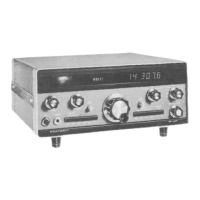TRANSMITTER TROUBLESHOOTING GUIDE
LT
jov4C
:c:
50
jkF
Refer to the 'Transmitter Block Diagram" (fold-out from
Page
268). which shows how signals flow through the
YH:~E
transmitter circuits, as you
go
through the tests on
the
70
following pages. Each circuit board is outlined with a dashed
pTOEfNTT
line, and the circuit functions are shown as solid blocks
*.--
inside the outlines.
This troubleshooting guide is divided into the following four
TO
IMP~DANCE HIGH
INPUT
VOLTMC~ER
sections: "Carrier GeneratorICrystal filter," "Transmitter
CHASSIS
il
MEGOHM
OR
HIGHERI
'
IF," "Driver," and "Power Amplifier." When you get the
DC
INPUT.
correct result for a test, proceed to the next one.
I4
you do
not get the correct result, the last step will direct
you to the
proper part
of the "Maintenance" section and will call your
2.
CONNECT VOLTMETER
I
attention to some specific areas to check. When you turn to
COMMON LEAD TO CHASSIS.
me "Maintenance" section:
1.
Refer to any applicable parts of
tJw
Figure
4-2
"Troubleshooting Chart."
2.
Refer
the
Chart"
and
check
the
To u, the RF detector, connect
it
as shown in Figure
4-2.
"'Itages
in
your
Transceiver
at
the
areas
DO NOT permit the terminal strip lugs to touch anything
mentioned
in
the
last
step. (Also
see
"Voltage
while the detector
is
in use. The assembled terminal strip
and Continuity Checks," Page
272).
--
//COW~~
yra?.&Afh~ap~e_@
.
insulate
.
--
it:
-{:!
i
I
3.
Check any questionable diodes and transistors,
See
Page
274.
4.
6e
are each circuit is correctly wired and that
CARRIER GENERATORlCR'fSTAL
FILTER
me correct parts are installed.
5.
~~~d the
"circuit
~~~~~i~ti~~*~
and study the
(
)
Connect a dummy load capable of dissipating 100
Schematic to better understand and analyze
watts to the ANT socket on the rear panel.
your problem.
(
I
Set
the BAND switch to 3.5.
TEST CIRCUIT PREPARATION
( )
Set the rear panel slide switch to COM.
When a transmitter circuit board
is
functioning properly, an
RF signal will be present at the output and input. Parts are
'
)
lurn
the
LEVEL
fully
furnished for a simple RF detector which can be used with a
high input impedance voltmeter for signal tracing
in-some
(
)
Depress the PWR. TUNE, and ON buttons. All ofher
low level RF circuits. See Figure
4-1
and the accompanying
buttons should be released.
steps on the
fold.out from Page
269.
k'
Refer to Figure
4-2
and connect the RF detector wires as
CAUTIONS: follows:
I
DO NOT use the detector on circuits Containing more
(
)
Red wire to the high input impedance voltmeter.
than
30
VAC or 30 VRF.
OLBU~E
(
1
Btaek
wire to the chassis of the Transceiver.
DO NOT use the detector on the PA circuit board or
its
output.
(
)
Gray wire to pin
6
of board
E.
I

